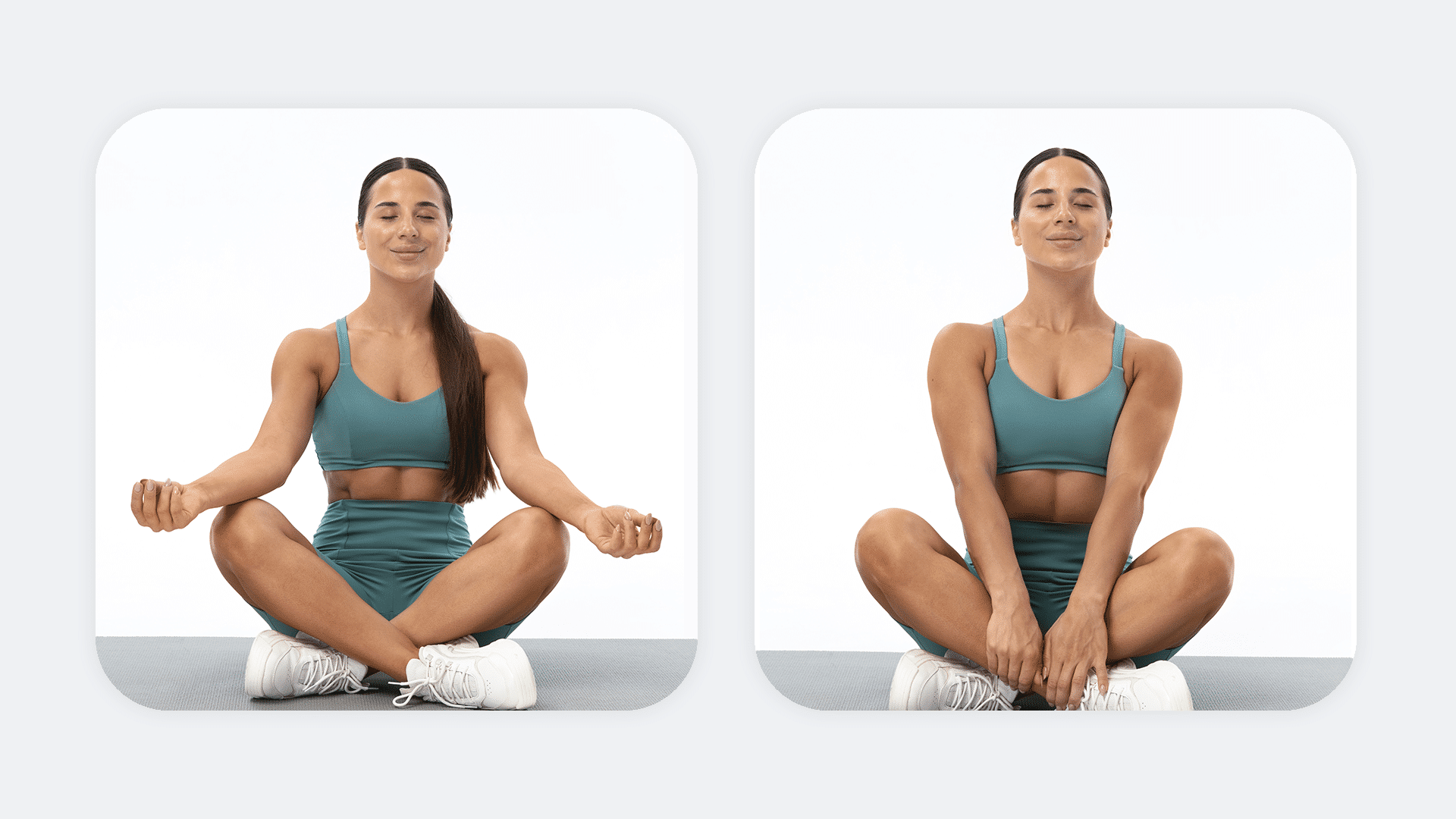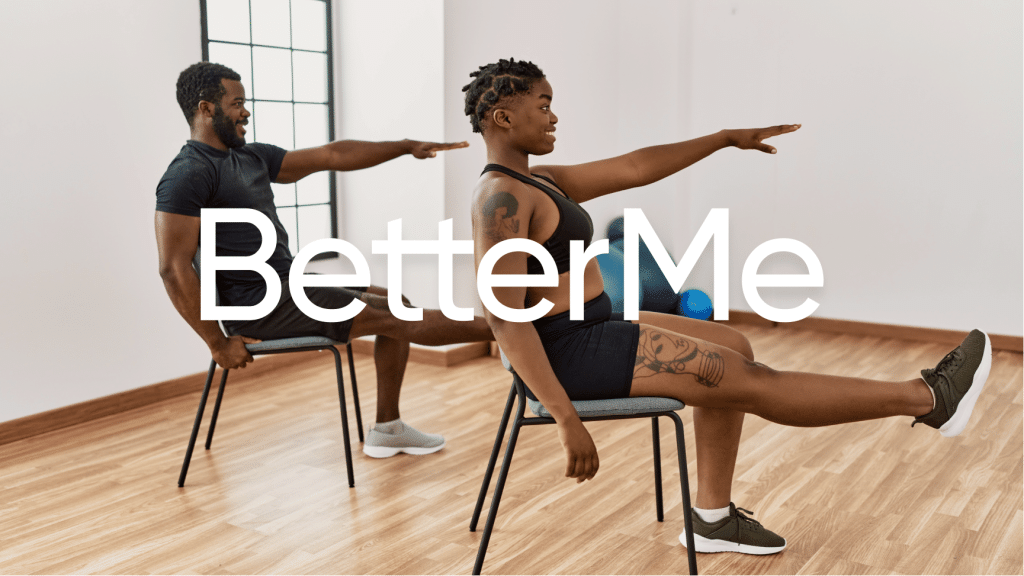For obese people, beginning a fitness regimen can present unique challenges such as limited mobility, joint pain, and feelings of self-consciousness. Yet studies have shown that regular physical activity is important for weight management and overall health (5). Chair yoga offers an accessible and effective solution to these concerns, enabling beginners to experience the benefits of yoga without exacerbating existing issues. This blog post will delve into the advantages of chair yoga for obese beginners, specifically addressing how it helps them overcome the obstacles associated with starting a fitness routine. Additionally, it will discuss the various benefits that can be gained from incorporating chair yoga into one’s regular exercise program.
What Is Chair Yoga?
Chair yoga is a unique form of yoga. It’s simple and adaptable. Instead of traditional yoga poses on a mat, you use a chair for support. This makes it perfect for people with limited mobility or those who cannot perform floor exercises.
The chair serves as a prop. It helps you maintain balance and stability while performing modified yoga poses. You can sit or stand, depending on the pose. This flexibility allows you to customize your practice according to your needs and comfort level.
Chair yoga incorporates various elements of traditional yoga. It includes breathing exercises, meditation, and gentle stretching. The focus is on improving flexibility, strength, and relaxation.
In a typical chair yoga session, you start with deep breathing exercises. This helps to calm the mind and prepare the body. Next, you move on to seated poses that target different muscle groups. Some standing poses may also be included, using the chair for support.
The session ends with a relaxation exercise. Here, you focus on releasing tension and stress from the body. This leaves you feeling refreshed and rejuvenated.
Read More: The Ultimate Guide To Gentle Chair Yoga For Beginners And Seniors
Is Yoga Good For Obese Beginners?
Yes, yoga is an excellent choice for obese beginners looking to start a fitness regimen. It provides numerous physical and mental benefits while addressing specific challenges that obese individuals may face.
Chair yoga benefits for obese beginners
1. Low-Impact Exercise
Traditional cardiovascular exercises, such as running or jumping, can place significant stress on the joints and muscles. For obese individuals, this may lead to discomfort or injury.
Yoga, on the other hand, is a low-impact exercise that helps build strength, flexibility, and balance without putting excess strain on the body (3).
2. Improved Flexibility
Limited mobility is a common concern among obese individuals. Yoga gently stretches and strengthens the muscles, increasing flexibility and range of motion over time. This can help alleviate stiffness, improve posture, and make daily activities easier (6).
3. Enhanced Strength
Yoga poses engage various muscle groups, helping to build strength throughout the body. Increased strength can reduce the risk of injury, support weight loss efforts, and improve overall physical function.
4. Weight Management
While yoga may not burn as many calories as high-intensity workouts, it can still contribute to weight management. The combination of strength-building poses, improved flexibility, and stress reduction can support healthier lifestyle habits that promote weight loss (1).
5. Stress Relief
Many obese individuals experience stress and anxiety related to their body image or weight loss journey. Yoga encourages mindfulness and deep breathing, which can help reduce stress levels and promote a positive mindset (8).
6. Body Awareness
Yoga teaches you to listen to and understand your body’s needs and limitations. This heightened body awareness can help obese beginners develop a safe and effective exercise routine tailored to their specific needs.
7. Inclusivity
Yoga offers various modifications and props, making it accessible to people of all shapes, sizes, and abilities. Obese beginners can start with gentler forms of yoga, like chair yoga or restorative yoga, and gradually progress as their confidence and abilities improve.
If you wish to cinch your waist, tone up your bat wings, blast away the muffin top – our fitness app was created to cater to all your needs! BetterMe won’t give excess weight a chance!
Can You Lose Weight Doing Chair Yoga?
The short answer is yes, you can lose a small amount of weight doing chair yoga. However, it’s essential to understand that weight loss is a complex process influenced by various factors.
And while chair yoga alone may not lead to significant weight loss, it can be a valuable component of a comprehensive weight loss plan.
By combining chair yoga with a healthy diet and other forms of physical activity, you can create a sustainable and enjoyable weight loss journey.
Here’s a closer look at the science behind chair yoga and weight loss.
Calorie Burning And Chair Yoga
Chair yoga is a low-impact exercise that involves gentle stretching and strengthening movements. While it does burn calories, it typically burns fewer calories than higher-intensity workouts like running or aerobics.
According to Harvard Medical School, a 155-pound person can burn approximately 114 calories during a 30-minute yoga session. In comparison, the same person could burn around 175 calories during a 30-minute brisk walk (2).
To lose weight, you must create a calorie deficit, meaning you burn more calories than you consume (4). While chair yoga may not be the most efficient calorie-burning exercise, it can still contribute to weight loss when combined with a healthy diet and other physical activities.
Read More: Does Chair Yoga For Lower Back Pain Help?
Additional Benefits For Weight Loss
Beyond calorie burning, chair yoga offers several other benefits that can support weight loss:
1. Improved Muscle Strength
Chair yoga helps build lean muscle mass, which can increase your resting metabolic rate. This means you’ll burn more calories even when you’re not exercising.
2. Stress Reduction
Chronic stress can lead to weight gain by triggering the release of cortisol, a hormone that promotes fat storage (7). Chair yoga encourages relaxation and stress relief, which can help regulate cortisol levels and reduce emotional eating.
3. Increased Mindfulness
Practicing yoga can enhance mindfulness, making you more aware of your body’s needs and hunger cues (9). This awareness can help you make healthier food choices and avoid overeating.
4. Enhanced Motivation
As you begin to experience the physical and mental benefits of chair yoga, you may feel more motivated to adopt other healthy habits, like regular aerobic exercise and balanced nutrition, that support weight loss.
What Is The Best Chair Yoga For Obese Beginners?
When it comes to chair yoga for obese beginners, selecting the most suitable poses and sequences is crucial for ensuring safety, comfort, and effectiveness.
Here are some of the best chair yoga practices backed by scientific research that can help obese beginners ease into a yoga routine.
Warm-Up And Breathing Exercises
Starting with gentle warm-up exercises and deep breathing helps to prepare the body and mind for the yoga practice. Some effective warm-up exercises include:
- Neck stretches: Gently tilt your head from side to side and forward and backward to release tension in the neck.
- Shoulder rolls: Circle your shoulders forward and backward to improve shoulder mobility.
- Seated cat-cow: Arch and round your back to increase spinal flexibility.
- Deep breathing: Practice diaphragmatic breathing to calm the mind and increase lung capacity.
BetterMe is your fast-track ticket to a long-lasting weight loss! Tailor your fitness journey and maximize your results with just a couple of swipes!
Seated Poses
Seated poses form the foundation of chair yoga, focusing on building strength, flexibility, and balance. Some beneficial seated poses for obese beginners include:
- Seated mountain pose: Sit tall with your feet flat on the ground, engage your core, and lengthen your spine. This pose helps improve posture and core strength.
- Seated twist: Gently twist your torso to one side while keeping your hips stable. This pose aids in spinal mobility and digestion.
- Seated forward bend: Hinge at your hips and fold your upper body over your legs. This pose stretches the hamstrings and lower back.
- Seated leg lift: Lift one leg at a time, either with a bent or straight knee. This pose strengthens the hip flexors and quadriceps.
Standing Poses
Incorporating standing poses with chair support can help build lower body strength and balance. Some suitable standing poses for obese beginners are:
- Chair-supported tree pose: Stand next to the chair and place one hand on it for support. Bend your opposite knee and place the foot on the inside of the standing leg. This pose improves balance and strengthens the legs.
- Chair-supported warrior II: Stand with your feet wide apart and your front foot facing forward. Use the chair for support as you bend your front knee and extend your arms out to the sides. This pose builds leg and upper body strength.
- Chair-supported triangle pose: Stand with your feet wide apart, one foot facing forward and the other turned slightly inward. Use the chair for support as you reach your front hand towards your front ankle, keeping your back straight.
This pose stretches the hamstrings, hips, and torso.
Cool Down And Relaxation
Finish your chair yoga practice with gentle stretches and relaxation exercises to release tension and calm the mind. Some effective cool-down exercises include:
- Seated spinal twist: Gently twist your torso from side to side to release any remaining tension in the spine.
- Ankle and wrist rolls: Rotate your ankles and wrists in circles to improve joint mobility.
- Guided relaxation: Close your eyes and focus on your breath as you systematically relax each muscle group in your body.
In conclusion, the best chair yoga for obese beginners includes a combination of warm-up exercises, seated and standing poses, and cool-down stretches.
By incorporating these practices into a regular routine, obese beginners can enjoy the numerous physical and mental benefits offered by chair yoga while gradually building strength, flexibility, and confidence.
What Else Should Obese Beginners Know About Chair Yoga At Home?
When starting a chair yoga practice at home, obese beginners should keep several key points in mind to ensure a safe, effective, and enjoyable experience. Here are some important tips for obese beginners practicing chair yoga at home:
1. Choose The Right Chair
Select a sturdy, stable chair without wheels or armrests. The chair should have a firm, flat seat and a straight backrest for proper support. Be sure that your feet can touch the ground when you’re seated
2. Create A Comfortable Space
Set up your practice area in a quiet, well-lit room with enough space to move freely. Consider using a non-slip mat under your chair to prevent it from sliding during your practice.
3. Wear Appropriate Clothing
Dress in comfortable, breathable clothes that allow for unrestricted movement. Opt for form-fitting attire that won’t get caught on the chair or restrict your range of motion.
4. Start Slowly And Progress Gradually
Begin with shorter, gentler sessions and gradually increase the duration and intensity of your practice. Listen to your body and modify poses as needed to accommodate your comfort and ability level.
5. Focus On Proper Alignment
Pay attention to your posture and alignment during each pose to avoid strain or injury. Consider practicing in front of a mirror or recording your sessions to monitor your form.
6. Incorporate Props And Modifications
Use props like straps, blocks, or cushions to help you achieve proper alignment and support in various poses. Don’t hesitate to modify poses according to your needs and limitations.
7. Warm-Up And Cool Down
Always start your practice with gentle warm-up exercises and deep breathing to prepare your body and mind. Likewise, end your session with a cool-down routine and relaxation exercises to release tension and promote recovery.
8. Consistency Is Key
Aim to practice chair yoga regularly, ideally several times a week, to experience its full benefits. Develop a routine that fits your schedule and preferences.
9. Seek Guidance
If you’re new to yoga or have specific concerns, consider seeking the guidance of a certified yoga instructor, preferably one with experience in chair yoga or working with obese individuals.
Online resources, video tutorials, and books can also be helpful for learning proper techniques and sequences.
10. Listen To Your Body
Always prioritize your comfort and safety during your practice. If a pose causes pain or discomfort, ease out of it and try a modified version or alternative pose. Never force your body into positions that don’t feel right.
Conclusion
In summary, chair yoga is an excellent option for obese beginners looking to embark on a fitness journey. With its gentle, low-impact nature and adaptability, chair yoga can help improve flexibility, strength, and mental well-being while accommodating various physical abilities.
By following the tips and recommendations provided in this article, obese beginners can safely and effectively practice chair yoga at home, gradually building confidence and experiencing the numerous benefits this practice has to offer.
DISCLAIMER:
This article is intended for general informational purposes only and does not serve to address individual circumstances. It is not a substitute for professional advice or help and should not be relied on for making any kind of decision-making. Any action taken as a direct or indirect result of the information in this article is entirely at your own risk and is your sole responsibility.
BetterMe, its content staff, and its medical advisors accept no responsibility for inaccuracies, errors, misstatements, inconsistencies, or omissions and specifically disclaim any liability, loss or risk, personal, professional or otherwise, which may be incurred as a consequence, directly or indirectly, of the use and/or application of any content.
You should always seek the advice of your physician or other qualified health provider with any questions you may have regarding a medical condition or your specific situation. Never disregard professional medical advice or delay seeking it because of BetterMe content. If you suspect or think you may have a medical emergency, call your doctor.
SOURCES:
- A preliminary investigation of yoga as an intervention approach for improving long-term weight loss: A randomized trial (2022, journals.plos.org)
- Calories burned in 30 minutes of leisure and routine activities (2021, health.harvard.edu)
- Exploring the therapeutic effects of yoga and its ability to increase quality of life (2011, ncbi.nlm.nih.gov)
- Fat loss depends on energy deficit only, independently of the method for weight loss (2007, pubmed.ncbi.nlm.nih.gov)
- Health benefits of physical activity: the evidence (2006, ncbi.nlm.nih.gov)
- Impact of 10-weeks of yoga practice on flexibility and balance of college athletes (2016, ncbi.nlm.nih.gov)
- Stress and Obesity: Are There More Susceptible Individuals? (2018, link.springer.com)
- The Effect of Yoga on Stress, Anxiety, and Depression in Women (2018, ncbi.nlm.nih.gov)
- Yoga’s potential for promoting healthy eating and physical activity behaviors among young adults: a mixed-methods study (2018, biomedcentral.com)













